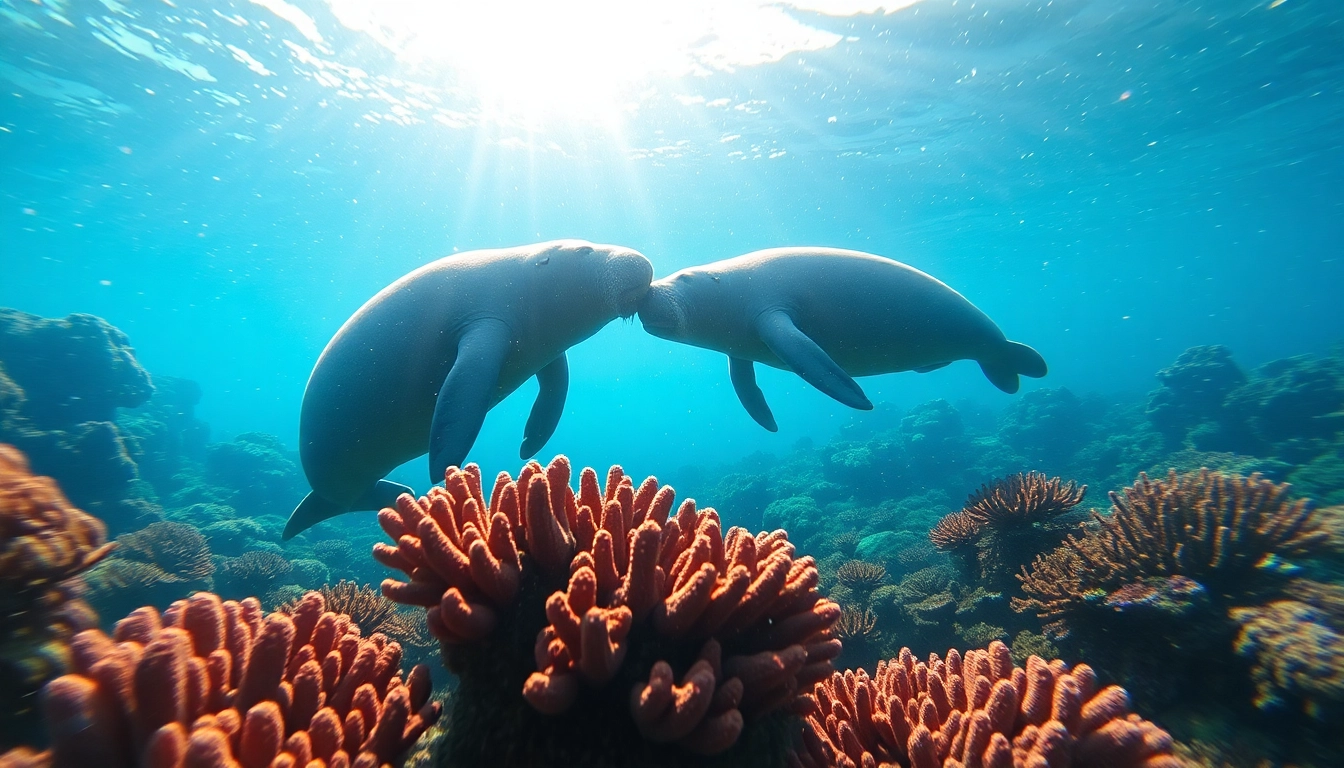
Visitors to Puerto Rico often find themselves captivated by its rich marine life, particularly the gentle giants known as manatees. Recognized for their tranquil nature and unique characteristics, these creatures hold a special place in the hearts of both locals and visitors alike. Exploring the enchanting world of manatees puerto rico is not just an adventure; it also poses an opportunity to learn about conservation and the delicate ecosystems that support these magnificent animals. This guide aims to provide a thorough understanding of manatees in Puerto Rico, covering their attributes, habitats, conservation efforts, viewing opportunities, and how you can get involved in protecting them.
Understanding Manatees Puerto Rico: Species and Habitat
Manatee Characteristics and Behavior
Manatees, often referred to as “sea cows”, belong to the order Sirenia, which includes three species: the West Indian manatee, the Amazonian manatee, and the African manatee. The West Indian manatee is the species most commonly associated with manatees puerto rico. These herbivorous mammals can typically weigh between 800 to 1,200 pounds and reach lengths of up to 13 feet. Their body is characterized by a large, rotund shape, a paddle-like tail, and two flippers, which they use for maneuvering through the water, feeding on underwater vegetation.
In terms of behavior, manatees are known for their gentle, slow movements. They thrive in warm, shallow waters and often graze on seagrasses, which form a significant part of their diet. As social creatures, manatees sometimes congregate in groups, though they are often solitary. These fascinating mammals communicate through a series of squeaks, whistles, and other sounds.
Natural Habitats in Puerto Rico
In Puerto Rico, manatees can be found in a variety of coastal waters, including lagoons, rivers, and estuaries where seagrass grows abundantly. The southern coast, with its calm and warm waters, becomes a haven for these gentle giants. Areas like the Guánica Bay and the Cabo Rojo National Wildlife Refuge have been recognized for their significance as breeding and feeding grounds for manatees. These habitats provide not only food but also shelter from stronger ocean currents and predators.
Freshwater habitats in the island’s rivers also support manatee populations, especially in areas like the Espíritu Santo River. However, specific habitats may face challenges due to human activities, pollution, and coastal development, making understanding their habitat needs crucial for conservation efforts.
Conservation Status and Efforts
Although manatees are integral to marine ecosystems, they face several threats, mainly stemming from human impact. Habitat loss, especially in coastal areas, poses a significant risk to their populations. Other dangers include boat strikes, entanglement in fishing gear, and pollution from agricultural runoff and urban areas.
In recognition of their endangered status, numerous organizations in Puerto Rico actively work on initiatives aimed at conserving manatees. The Caribbean Manatee Conservation Center plays a vital role in rescue and rehabilitation efforts, along with conducting research on manatee behavior and ecology. Their work includes community education and outreach to raise awareness about the importance of protecting these animals and their habitats.
Best Locations to See Manatees Puerto Rico
Top Viewing Spots in Puerto Rico
For those hoping to catch a glimpse of manatees in their natural habitat, several locations throughout Puerto Rico are prime spots for observation:
- Condado Lagoon: Located near San Juan, this urban lagoon often sees manatees cruising for food during early morning hours.
- Cabo Rojo: Its calm waters and expansive seagrass beds make it a vital area for manatee sightings.
- Guánica Bay: Known for its beautiful beaches and diverse marine life, Guánica Bay is another excellent spot for manatee watchers.
- Espíritu Santo River: This river’s tranquil setting can often yield sightings of manatees swimming leisurely.
Accessing Manatee Habitats Responsibly
Engaging with manatees and their habitats requires a responsible approach to ensure their well-being. Observers should maintain a safe distance from these creatures, as they can become stressed by close proximity. Snorkeling, kayaking, or paddleboarding in designated areas following local guidelines are recommended methods for viewing manatees without disrupting their natural behavior.
Boaters are particularly urged to observe speed limits in known manatee habitats to reduce the risk of collisions, a leading cause of injury among these animals. In addition, always refrain from touching or feeding manatees, as these actions can disrupt their natural behaviors and health.
Seasonal Sightings and Migration Patterns
Manatee sightings can vary throughout the year, influenced by specific seasonal patterns. While these gentle giants can be spotted at any time, certain times of year may increase the probability of sighting them. Warmer months are particularly favorable for manatees, as they tend to stay closer to shallow waters and seagrass beds.
During cooler months, especially in winter, manatees may migrate toward warmer waters, including thermal springs or coastal areas where temperatures remain suitable. Observing these migration patterns can provide opportunities for more frequent sightings.
Experience Activities with Manatees Puerto Rico
Snorkeling and Swimming Opportunities
For those wanting to experience close encounters with manatees, snorkeling in known habitats can be a rewarding adventure. Several locations in Puerto Rico offer snorkeling tours that allow visitors to explore the underwater world while seeking out these gentle herbivores. Guided snorkeling tours often include educational components about the surrounding marine environment and the importance of conservation.
Safety regulations are crucial when swimming or snorkeling near manatees; always prioritize their comfort and avoid disturbing them. Effective snorkeling can grant visitors views of not only manatees but also vibrant marine ecosystems, making the experience memorable and insightful.
Kayaking Tours with Manatees
Kayaking offers a peaceful way to explore manatee habitats while minimizing disturbance to the ecosystem. Several operators provide guided tours through the serene waters where manatees are known to frequent. These tours often highlight the surrounding flora and fauna, creating a holistic understanding of the delicate ecosystems where manatees reside. Choosing eco-friendly kayak rental services can help minimize environmental impact and promote sustainable interaction with wildlife.
Community Involvement and Educational Programs
Engaging with local conservation efforts is an excellent way to deepen your understanding of manatees and their importance. Community programs aimed at educating the public on conservation issues regarding marine life are abundant throughout Puerto Rico. Many of these programs offer opportunities for hands-on experiences, including volunteering for habitat restoration projects or participating in educational workshops.
Local universities and conservation groups often hold talks, events, and workshops that foster greater awareness of manatee conservation efforts and marine ecosystems. Joining these initiatives not only broadens knowledge but also helps support ongoing preservation efforts.
Supporting Manatees Puerto Rico Conservation
Volunteer and Donation Opportunities
Getting involved in manatee conservation can take many forms, including volunteering your time or offering financial support to organizations dedicated to protecting these creatures. Many conservation centers and non-profits seek volunteers for various initiatives, from assisting in rescue operations to contributing to educational programs.
Additionally, donating to established wildlife conservation organizations helps fund vital research, rehabilitation, and outreach programs necessary for the protection of manatees and their habitats. Each contribution, no matter how small, can make a difference in efforts to preserve these remarkable animals.
Participating in Local Conservation Initiatives
Many local initiatives focus on improving the conditions and environments where manatees thrive. By participating in beach clean-ups, attending community workshops, or joining local advocacy groups, individuals can help mitigate threats faced by manatees and similar marine species. These grassroots efforts often yield a positive impact; they create greater awareness and build community consciousness around the importance of preserving Puerto Rico’s ecological heritage.
Engaging with Educational Resources
For those keen to learn more about the intricate lives of manatees and their ecosystems, numerous resources are available both in print and online. Websites, documentaries, and local library materials can provide valuable insights and stimulate further interest in conservation topics. Educational institutes often offer public lectures, marine biology programs, and classes that touch upon marine conservation efforts, making it easier for everyone to get involved.
Frequently Asked Questions about Manatees Puerto Rico
What are the best times to see manatees in Puerto Rico?
The best times to see manatees typically coincide with warmer weather, especially during spring and summer when they are more likely to be found in shallow waters. Early morning excursions can also increase the chances of sighting these gentle giants as they come up for air to breathe.
Are manatees safe to swim with?
While manatees are generally gentle and non-aggressive, it is crucial to maintain a respectful distance. Swimming too close or touching them can cause stress to the animals and disrupt their natural behaviors. Observing them from a distance while snorkeling or kayaking allows both the animal and the observer to have a safe and enjoyable experience.
How can I report injured manatees?
If you come across an injured or stranded manatee, it’s essential to contact local wildlife authorities immediately. Providing accurate information, including the location and condition of the animal, can aid in rescue and rehabilitation efforts. Many agencies provide hotlines or direct contacts for reporting marine animal emergencies.






